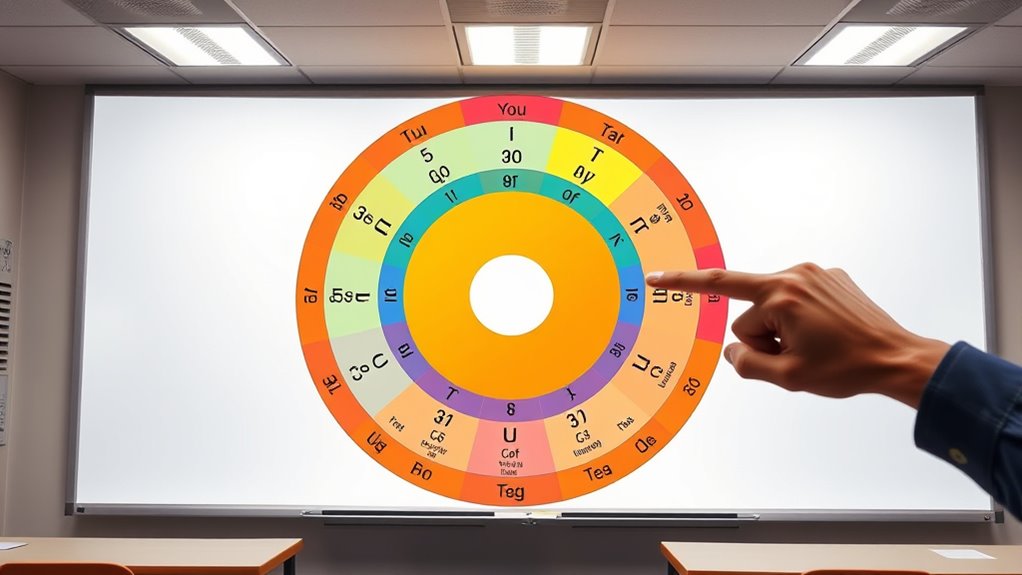To memorize the Circle of Fifths in 15 minutes, break it into smaller sections, like four or three keys each, and use visual aids like color-coded charts or flashcards. Employ mnemonics and associations to connect each key quickly, practicing within each zone repeatedly. Use active recall and quick daily routines to reinforce your memory fast. Keep practicing and reviewing, and you’ll find yourself mastering it in no time—keep going for more tips to speed up even further.
Key Takeaways
- Break the circle into smaller sections (e.g., groups of 3-4 keys) and memorize each segment separately.
- Use visual aids like color-coded charts and flashcards for quick recognition and association.
- Apply mnemonics such as “Father Charles Goes Down And Ends Battle” to recall key signatures efficiently.
- Practice active recall daily by testing yourself on segments and gradually linking them to form the full circle.
- Incorporate the circle into playing, improvising, or transposing to reinforce memory through practical application.
Understanding the Circle of Fifths and Why It Matters

The Circle of Fifths is a fundamental tool for musicians because it visually maps out the relationships between keys, making it easier to understand music theory. When you look at the circle, you see how keys relate through perfect fifths, which helps you grasp key signatures, chord progressions, and modulations. It reveals patterns that might seem confusing at first but become clear once you see their connections. Understanding the key signatures and how they relate across different keys is essential for mastering the circle. Knowing the circle improves your ability to transpose music, improvise, and compose. Instead of memorizing isolated facts, you understand how keys flow into each other naturally. This understanding accelerates your learning process, saving you time and frustration. Mastering the circle is essential for developing a solid foundation in music theory and enhancing your overall musicianship. Understanding key relationships allows musicians to navigate complex compositions with greater confidence and creativity. Additionally, recognizing interval patterns within the circle can further deepen your grasp of how scales and chords interconnect, enriching your musical intuition.
Breaking Down the Circle Into Manageable Sections

To master the Circle of Fifths quickly, you should break it into smaller sections. Focus on one segment at a time to build familiarity and confidence. By creating focused practice zones, you’ll improve your speed and understanding more efficiently. Incorporating musical theory concepts such as key signatures and chord progressions will further solidify your grasp on the circle. Additionally, understanding the relationship between keys can help you see connections more clearly and memorize the circle more effectively.
Segmenting the Circle
Breaking the Circle of Fifths into smaller sections makes it easier to learn and memorize. By dividing the circle into manageable parts, you can focus on one segment at a time. For example, consider splitting it into three groups of four keys each. This way, you can master each section before moving on to the next. Here’s a simple way to visualize it:
| Section 1 | Section 2 | Section 3 |
|---|---|---|
| C Major | G Major | D Major |
| F Major | B♭ Major | E♭ Major |
| A Minor | E Minor | B Minor |
Segmenting the circle in this manner aligns with effective learning strategies that enhance retention and understanding. Additionally, practicing musical scales within each segment can reinforce your familiarity with the keys and improve overall memorization. Incorporating visual aids, such as diagrams or color coding, can further boost your ability to quickly recall the key signatures associated with each section. Using memory techniques, like associating each segment with a specific mnemonic, can also make the process more engaging and efficient.
Focused Practice Zones
Focusing on specific zones within the Circle of Fifths helps you learn more efficiently. Instead of trying to memorize the entire circle at once, break it into manageable sections. For example, start with the key signatures related to C major and G major, then move clockwise or counterclockwise. Focus on one zone at a time, mastering the relationships and patterns within that segment. Use visual cues, such as color coding or highlighting, to reinforce your memory. Practicing these zones repeatedly helps solidify your understanding and makes the overall circle less intimidating. As you become comfortable with each section, gradually connect them to see the larger picture. This targeted approach streamlines your learning process and speeds up your mastery of the Circle of Fifths.
Using Mnemonics and Memory Tricks to Accelerate Recall

Using mnemonics and memory tricks can substantially speed up your ability to recall the circle of fifths. To make it easier, try these approaches:
Mnemonics and visual tricks make mastering the circle of fifths faster and easier.
- Create a phrase where each word’s initial matches a key signature, like “Father Charles Goes Down And Ends Battle” for F, C, G, D, A, E, B.
- Use visual associations, linking each key to familiar images or places.
- Break the circle into smaller chunks, memorizing 2–3 keys at a time.
- Repeat the sequence aloud daily, reinforcing the order through rhythm and sound.
- Incorporate musical theory concepts to deepen your understanding and strengthen memory connections.
- Engaging in sound healing science techniques, such as listening to specific frequencies, can also enhance your focus and memory retention during practice.
- Regularly inspecting your home furnishings, like your musical space setup, can create a comfortable environment conducive to learning and memorization.
- Understanding the relationships between keys within the circle of fifths can further solidify your grasp and facilitate quicker recall.
These techniques help anchor the information in your memory, making recall quicker and more intuitive during your speed-run.
Practicing With Visual Aids and Flashcards

Practicing with visual aids and flashcards can considerably enhance your ability to memorize the circle of fifths. Visual tools provide a clear, memorable layout of the relationships between keys, making it easier to internalize the pattern. Flashcards allow you to test yourself actively, reinforcing your recall through repetition. By regularly flipping through cards with key signatures and their positions, you strengthen your memory muscles. You can also create your own flashcards with colors and symbols to make associations more vivid. Using visual aids helps break down the complex circle into manageable chunks, boosting your confidence. Consistent practice with these tools turns passive recognition into active recall, speeding up your mastery of the circle of fifths in just 15 minutes.
Creating a Quick Repetition Routine for Fast Mastery

To master the circle of fifths quickly, establishing a focused repetition routine is essential. First, set aside 5-minute intervals throughout your day dedicated solely to review. Second, use a mix of flashcards, reciting the sequence out loud, and visualizing the circle to reinforce memory. Third, break the circle into sections—start with key signatures, then connect them step-by-step. Fourth, test yourself by covering parts of the circle and recalling them from memory, gradually increasing difficulty. Keep this routine consistent, avoiding distractions, and focus on rapid recall rather than perfection. This approach guarantees your brain forms strong associations fast, making the circle of fifths second nature in just minutes a day. Incorporating memory techniques such as association and visualization can further enhance retention and speed up mastery. Additionally, maintaining a consistent practice schedule helps solidify your memorization progress over time.
Incorporating the Circle Into Your Daily Practice

To make the circle of fifths a habit, incorporate it into your daily routines. Try matching it with songs you play regularly or use flashcards to reinforce your memory. Consistent practice is key to mastering it quickly. Additionally, engaging in dynamic communication exercises related to music theory can deepen your understanding and retention. Incorporating visual aids, such as diagrams or color-coded charts, can also enhance your memorization process. Using exposure to different keys in your practice can further solidify your familiarity with the circle of fifths.
Daily Practice Routines
Incorporating the Circle of Fifths into your daily practice can substantially boost your understanding of key relationships and improve your overall musical intuition. To make it effective, follow a simple routine:
- Spend 2-3 minutes reviewing the circle, memorizing key signatures and their relationships.
- Play scales or chords in different keys, focusing on the transition points indicated by the circle.
- Test yourself by recalling the next key clockwise or counterclockwise without looking.
- Incorporate the circle into your improvisations or compositions, applying the relationships practically.
This consistent approach helps reinforce your memory and deepens your grasp of key progressions, making the circle second nature in your musical journey.
Incorporate With Songs
Integrating the Circle of Fifths into your songs can make key shifts more natural and intuitive. Start by selecting simple progressions that move through neighboring keys. Practice transposing familiar melodies into different keys using the circle as your guide. This helps you internalize relationships and improves your adaptability. To visualize, try this table:
| Key | Related Key |
|---|---|
| C | G |
| G | D |
| D | A |
| A | E |
| E | B |
Use these relationships to create variations or experiment with modulations. Incorporate these into your daily practice to reinforce your understanding and make key changes feel seamless. Over time, this will boost your musical intuition and ease your passages between keys.
Use Flashcards Regularly
Using flashcards regularly can considerably reinforce your understanding of the Circle of Fifths and improve your ability to recall key relationships quickly. To maximize effectiveness, incorporate them into your daily routine. For example:
- Review a set each morning to start your day with fresh memory.
- Use them during breaks to reinforce connections between keys.
- Shuffle the cards frequently to challenge your recall under different contexts.
- Test yourself by trying to identify relationships without looking, then check your accuracy.
Tips for Retaining Your Memorization Long-Term

To guarantee your memorization of the Circle of Fifths lasts, it’s essential to reinforce your learning regularly. Spaced repetition is key—review the chart daily at first, then gradually spread out sessions over weeks. Teach the concept to someone else; explaining it helps solidify your understanding. Incorporate the Circle of Fifths into your daily practice, such as identifying keys while playing or analyzing songs. Keep testing yourself with quizzes or flashcards to reinforce memory. Visualization also helps: picture the circle in your mind and trace the relationships between keys. Finally, stay curious—try applying the circle in different musical contexts. Consistent, active engagement ensures your memorization remains fresh and durable over time.
Frequently Asked Questions
How Long Does It Typically Take to Memorize the Entire Circle?
You might wonder how quickly you can memorize the entire circle. Usually, it depends on your familiarity with music theory and your memorization skills. Some people can do it in just a few hours with focused practice, while others may need a couple of days to internalize all the key signatures and relationships. Consistent review helps reinforce your memory, making the process faster over time.
Can These Memorization Techniques Apply to Other Musical Concepts?
Did you know that most musicians spend about 20% of their practice time on foundational concepts? When it comes to memorization techniques, you can definitely apply them to other musical ideas like scales, chords, or progressions. These methods boost your memory and understanding, making learning faster. So, if you master these techniques for the circle of fifths, you’ll find it easier to grasp and internalize many other musical concepts too.
What Are Common Mistakes Beginners Make When Learning the Circle of Fifths?
When learning the circle of fifths, you often make mistakes like memorizing it without understanding, rushing through the process, or neglecting to practice regularly. You might also struggle with recalling key signatures or mixing up major and minor keys. To avoid these errors, break it down into smaller sections, practice daily, and focus on understanding how keys relate to each other. This way, your grasp of the circle becomes stronger and more intuitive.
Is It Necessary to Understand Music Theory Beforehand?
Think of learning music theory like building a house—you need a solid foundation. While you don’t need to master everything first, understanding key concepts helps you grasp the circle of fifths more easily. I struggled at first until I learned basic scales, which made the circle click. So, yes, some prior knowledge makes memorizing and applying it faster and more intuitive, but you can start with simple ideas and grow from there.
How Can I Test My Memorization Accuracy Effectively?
To test your memorization accuracy effectively, challenge yourself by recalling the circle of fifths from memory, then check your results. Use flashcards or quizzes to identify areas where you struggle. Practice repeatedly until you can recall the entire circle confidently. You can also try writing it out from memory or explaining it aloud. Consistent self-testing helps reinforce your knowledge and highlights your progress.
Conclusion
With consistent practice, you’ll find yourself sailing smoothly through the circle of fifths, like a gentle breeze guiding a leaf along a clear stream. By breaking it down and using simple tricks, you’ll turn a formidable mountain into a manageable hill, making mastery feel like a natural flow. Keep the rhythm steady, and soon, the whole circle will become a familiar dance that you can recall effortlessly, like a favorite song buried deep in your mind.









